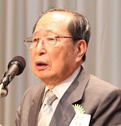��Vocational Service Month�� Meeting
Secrets behind Viable Business Management of Shinisé
October 24, 2012
Dr. Tsunehiko Yui
Director, Mitsui Archives and Museum
 I am afraid there is no exact English translation for ��shinisé�� (long-established business). ��Old shop�� or ��established shop�� is associated with old-fashioned out-dated shops. I want to make shinisé an international term, which conveys the friendly ambiance that we Japanese are familiar with.
I am afraid there is no exact English translation for ��shinisé�� (long-established business). ��Old shop�� or ��established shop�� is associated with old-fashioned out-dated shops. I want to make shinisé an international term, which conveys the friendly ambiance that we Japanese are familiar with.
1. Concept of shinisé
����One low price if you pay cash�� was the world��s first business practice introduced by Mitsui Echigoya Kimono Store (currently Mitsukoshi) as early as in 1682. It was the world��s best and largest retailer in the 18th century, in terms of sales figures, number of employees, ground-floor area and accuracy of book-keeping.
��This business innovation spread quickly in Japan. In 30-40 years, Shirokiya opened its business, followed by Matsuzakaya, Takashimaya and Daimaru. These five department stores achieved considerable business turnover by the mid-18th century.
��Total employees of Echigoya exceeded 1,000, making it the largest retailer in the world. It is also noteworthy that Chuodori, the main street connecting Nihonbashi and Ginza, was the world��s busiest commercial avenue in the 18th century. Nihonbashi bridge celebrated its centennial anniversary of construction last year. 20 major retailers around the bridge organized the commemorative events, and I was impressed to find out all of them have remained in business to date, proving the excellent commercial capability of Japanese shinisé.
2. Long-running companies in Japan
��Among the 1.5 million retailers compiled by the Teikoku Data Bank research company, 2,879 retailers began operation before the Meiji Restoration (1868), of which 247 have been based in Tokyo. Townspeople and merchants flourished during the Genroku era (1688-1704) and started new businesses. The 8th Tokugawa Shogun Yoshimune instigated the stringent Kyoho Reforms (1730s), yet such businesses did survive through the serious depression.
��I intend to make an international comparison on business management of shinisé around the world to examine the factor behind its sustainability.
Japan enjoys the highest level of longevity, so do its companies, partly because Edo was the world��s largest metropolis. Its population totaled 1 million by the Genroku era and reached 1.2 million after the Kyoho era.
3. Tradition of the Edo shinisé merchant houses
��Why have the large-scale retail stores of the Edo era survived over 300 years? It is because they secured a reliable crisis management system. While Edo was inflicted by numerous outbreaks of fire, most of them did stay in business.
��I studied the layout of Shirokiya constructed at Nihonbashi in 1732. The Tokugawa shogunate started permitting construction of large-sized buildings in the Genroku era. Two-story buildings with white plastering walls and roof tiles became common. Such buildings had many big and solid storehouses, with thick walls and well-developed fire-resistant installation. When a fire broke out, the employees threw the whole merchandise into storehouses, locked them and run away, while the fire extinguishers discharged water to keep storehouses from burning. This way, your merchandise and people remained intact, and you could re-start business in a short span. It was common to resume business in a makeshift store within a week.
��Employees were also assigned to different duties should a fire break out, based on a comprehensive crisis management scheme. Each house had a watchtower on its roof, so that prompt actions could be taken for fires even far away, depending on wind direction.
��The Ansei Great Earthquake (1855) claimed 4,000 lives, most of whom were victims of collapsed buildings. Fires were completely extinguished by the following day. On the other hand, as many as 100,000 people are said to have lost their lives in the Great Kanto Earthquake, majority of them from fire. These figures prove how effective disaster-prevention measures of shinisé were in the Edo era.
4. Business management principle and skills of shinisé
��The Edo-era shinisé had many important traditions, based on the principle which valued business continuation over profit-making. ��Going concern�� implies ��keep making money,�� while ��sustainability�� has a different tone of simply keep going.
����Trust others�� was another common family precept found after the Genroku era, which encourages to trust your employees, enhance their capabilities and reward them on the basis of competence and ability. You need competent assistant managers to keep your stores running. How to employ promising candidates and train the mid-level managers became crucial.
����Frugality, resourcefulness and calculation�� were believed to be the three essential factors for efficient business management in the Edo era.
����Frugality�� meant maintaining solid management to avoid deficits and risky business. ��Resourcefulness�� meant innovation. And ��calculation�� meant accurate bookkeeping and account settlement. I believe these three factors continue to be the key for our skill improvement up until now.